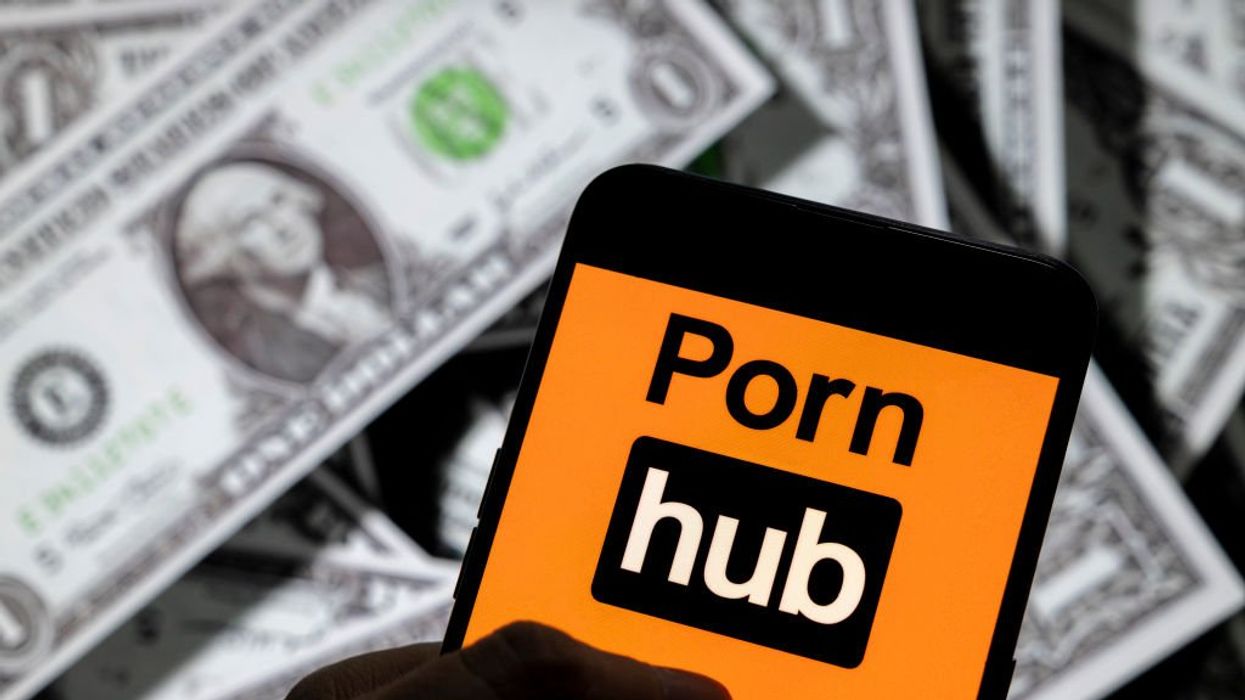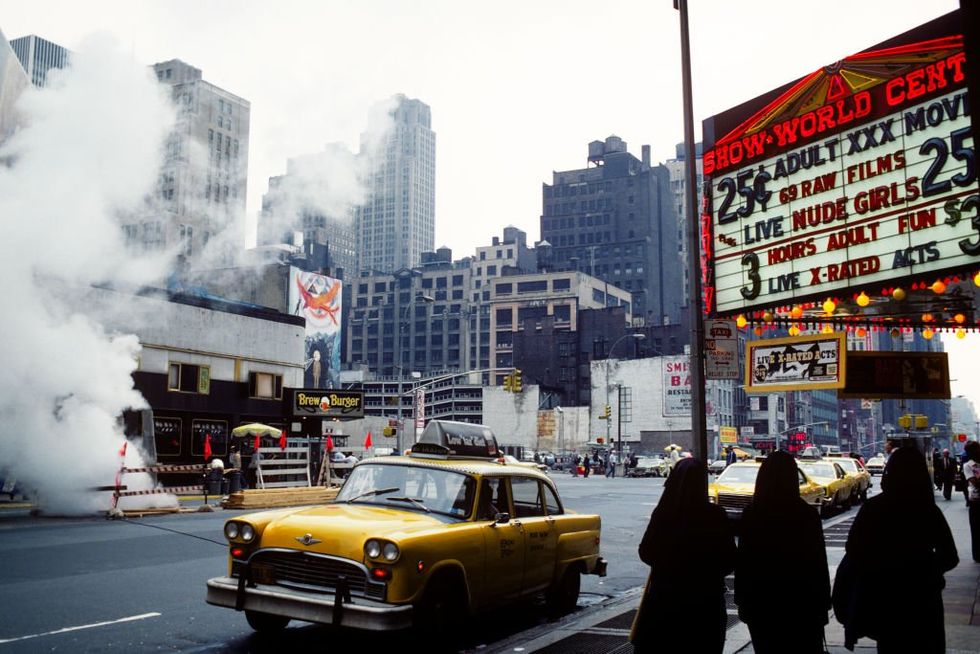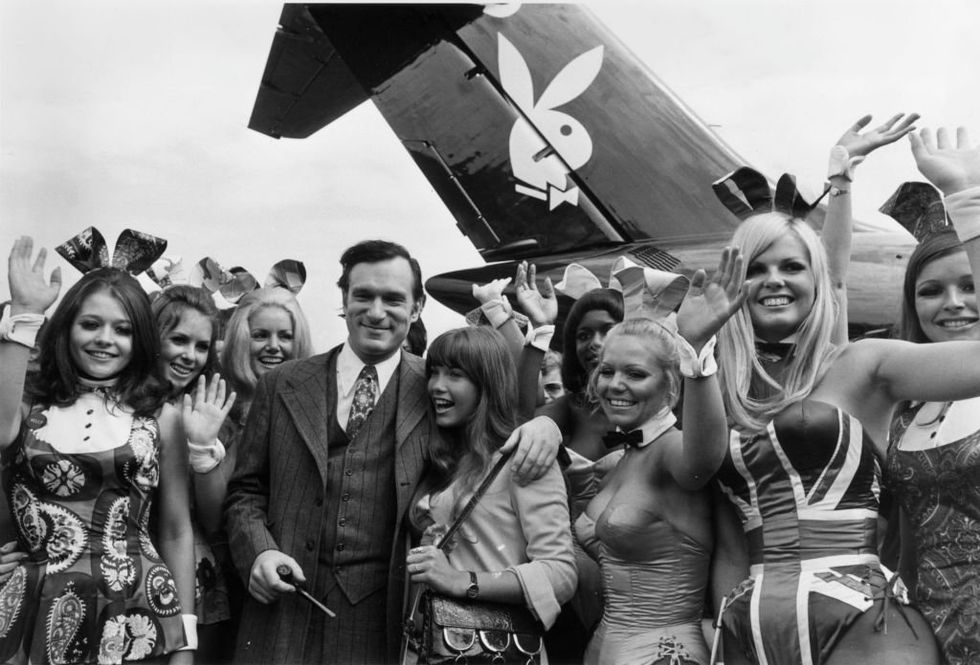
SOPA Images/Getty
When you gaze into the blue light of the digital abyss, does the digital abyss gaze back? Something very creepy is happening in porn. It’s discussed in hushed tones and casual jokes, but it’s there, and not just in some dark corner of the web. There has been a decidedly depraved turn to the search queries and tastes of consumers of the explicit. Currently, PornHub and other mainstream sites, which tens of millions visit daily, are filled with every conceivable incarnation of incest taboos in 4K. The videos showing simulated – one sincerely hopes – rape, gang rape, necrophilia, sexual blackmail, and pedophilia on your phone are myriad. How does a society grapple with a $100 billion industry producing content so disturbing?
The finest bit of writing ever done on the American pornography industry was by David Foster Wallace when he wrote the essay “Big Red Son” for Premiere magazine, which was later included in "Consider the Lobster." Wallace realized that as porn became more familiar in the culture, in order to be transgressive and excite the viewer, it would have to push the limits of decency to remain taboo. As with most of his work, it was sprawling, self-indulgent, and brilliant. He was on assignment at the Adult Video News Awards and the “Adult Software” portion of the Consumer Electronics Show.
Taking place in Las Vegas, the AVN awards are the Oscars for the smut industry and are only slightly less ridiculous and masturbatory than the Hollywood version. Lycra-clad women with cartoonish augmentations take the stage to accept awards, along with men praying the angel of #MeToo passes over them and assorted older, lecherous scumbags who direct and produce the American sexual id. The irony-free categories run the gamut from the anodyne-like Best Director to the unintentional comedy of Best MILF.
There is an overlap between porn and the Consumer Electronics Show, which takes place in Vegas every year around the same time and is the largest trade show in the world. Companies of every size showcase cutting-edge technology to hundreds of thousands of attendees. I formerly covered the event for years and experienced firsthand this conflagration of the world’s tech and sex industries. It usually involved invitations to off-site hotel rooms where the depressing prospect of raunchy VR or sex doll presentations was dangled. One time, the opportunity to test out a dildo controlled by an app was exuberantly offered by a Japanese company. The offer was politely declined. There are usually girls from the industry there in the booths. They always had the same dead-eyed sadness one sees in the faces of sex workers while walking the red light districts of Bangkok or Amsterdam. David Foster Wallace was prescient in his essay on this salacious turn the culture has taken. But to understand his critique, you need a bit of context.

In many ways, you can’t tell the story of porn without telling the story of technology. A stroll through any natural history museum will usually provide Egyptian or Greek renderings of couples in copulation. In an ancient Roman brothel in Pompei, tourists can take pictures of well-preserved frescoes depicting orgies. It’s believed some of the first movies ever made were erotic, almost as soon as the invention of moving pictures.
In America and Europe in the 20th century, illicit films and magazines became more available to the general public with the rise of Playboy magazine and soft-core theaters popping up in cities. Porn was still in a legal gray area, with some courts banning it and others defending it on First Amendment grounds. In the early 1970s, there was a seismic shift, as much of the production moved from New York City to California, and the culture became more open to artistic films with nudity and even actual sex. "Deep Throat," starring Linda Lovelace, came out in 1972 and was a sensation, and Variety reported it was one of the 10 highest-grossing films of that year. Celebrities from Truman Capote to Johnny Carson to Barbara Walters went to see it.
In the 1980s, videocassettes drove a transformation from artistic to unadulterated titillation. VCRs allowed for privacy and freedom from other consumers or the fear of a vice raid. Video led to the rise of porn stars like Ginger Lynn and Nina Hartley while also dramatically reducing production costs, allowing more movies to be made and more specific fantasies and fetishes to be explored. In 1987, the landmark California Supreme Court case California vs. Freeman effectively legalized hard-core pornography.
Saying the internet changed everything is a trite cliché. However, there’s no denying that being able to access the most degenerate material with a few taps on your phone has probably had an effect on our sexuality. Unfortunately, that effect is hard to pin down empirically; there aren’t many scientific studies on this issue. But that doesn’t mean millions of people watching billions of hours of simulated sexual violence on their phones is good for the moral fabric of a society.
It’s easy to view porn as a solitary activity. Perhaps a lonely young man watches a movie, and we assume there were better uses of his time. No harm done; why worry about what’s done behind closed doors? This line of thought ignores the horrific sexual exploitation of the women who make this content. The other less-reported aspect is porn’s deleterious effect on young men. In the course of writing this article, I spoke with or emailed numerous men on and off the record who have had their lives destroyed by porn. Divorce, decimated relationships, and tens of thousands in credit card debt were familiar stories. Every person expressed deep-seated shame, regret, and a complete loss of control.
I think the startling standard version of this narrative can be summed up by a young man interviewed for the story. Michael (for obvious reasons, we’ve elected to use a pseudonym to protect his identity) is an intelligent young man from a traditional two-parent middle-class background in the U.K. What began as a seemingly benign exploration began to devolve into something much more serious.
“I basically began spending my whole days watching porn, all day, every day, for hours upon hours,” he explains. “When school finally came round again ... I couldn’t break my routine, and on school days where I had to be up by 7:00 a.m., I was staying up way into the early hours to watch porn.”
Michael explained how this vicious cycle leads to spiraling and a feeling of self-hatred, and it results in trying to find darker and darker subject matter to keep up the thrill.
“I – and I assume many other porn addicts and porn watchers – have gone down a bit of a rabbit hole and ended up watching or becoming interested in some porn categories that are probably very left of field and unhealthy; some even have gone as far to watching very dark and potentially even illegal acts, most of which were broadcast on mainstream sites such as PornHub, Xvideos, Twitter, or Reddit.”
Through therapy and sheer self-will, he got his life back on track and worked to stay porn-free. He explained it’s difficult because everyday life has many triggers, from Instagram to video games to television commercials. Trying to avoid those triggers is a constant struggle. He sees a society that refuses to recognize this as a serious problem.
“I think porn is leaving a silent trail of destruction amongst young women and men,” Michael adds, “making us ever more insecure, breeding unhealthy and violent attitudes towards sex, and as the porn viewership around the world goes up, and up each passing year, sadly, there will be some ... lonely souls, that fall into that abyss, of really dark and illegal content which can often lead to real-life consequences.”
As the allure of pixelated abuse draws in more and more young people, some are trying to raise awareness of the pitfalls. Interviewing Dominic Victor, you get the sense that he doesn’t fit the stereotype of the average consumer. He’s a college student from Kansas State University who’s articulate and possesses quintessential All-American good looks. Unfortunately, porn became a severe distraction in his life. “I could no longer love people and be present. It really took away my ability to think, my ability to be myself.”
After fighting to overcome those demons, he’s trying to help others he sees wallowing in the same mire. He’s become a public speaker with various Catholic organizations trying to help other young men and women who’ve fallen into the doom-scrolling of sexual exploitation. He’s very candid about a topic that makes most people blush, which helps his words resonate. He sees a generation of young people trapped in a horrific cycle of depression and shame, sapping their self-confidence.
“It hits something in the male brain. I was trying to find the next shock value. The next novel thing, that’s where it gets darker and darker because it is just so crazy. So, absurd, and yet something in the male brain is being turned on.”
Mr. Victor uses the tactics he’s learned to help other kids. He explains that therapy can be an excellent way to get help from a professional in a safe environment. He also recommends establishing accountability with a trusted friend or family member, using software called CovenantEyes. It’s an app you install on your devices that sends an alert to another person if you access porn. He says it’s a powerful disincentive and creates accountability.
He’s hopeful young people can overcome this addiction. “Your brain is hardwired for pornography because of our brain’s neuroplasticity, but that’s also good news because that means that it can be fixed. You can heal.”

There was a time when porn was on the cutting edge, and it was usually some angry Christian homemaker, opportunistic politician, or second-wave feminist seeking to ban it. All the hip people were fans, and getting invited to the Playboy Mansion was the height of cultural caché. Some iconic writers gave Playboy a veneer of respectability to the imaginary man who read it for the articles. Murakami, Vonnegut, Vidal, Kerouac, Marquez, and Mailer authored pieces for the magazine. Hugh Hefner further propagated his message on television with "Playboy After Dark." Hugh Hefner was cool, and consenting adults looking at pictures of beautiful women topless probably is pretty harmless.
But that’s not what’s happening now. It’s violent and obscene. It’s not cool. And for the first time, we’re seeing celebrities talk about how harmful it is.
Recently in an interview with Howard Stern, pop star Billie Eilish weighed in on how detrimental porn had been to her understanding of sex. “The first few times I, you know, had sex, I was not saying no to things that were not good. It was because I thought that’s what I was supposed to be attracted to,” she said.
There is surprisingly a small number of scientific studies attempting to empirically research porn. One academic trying to research it is Dr. Stephen Sammut from the Franciscan University of Steubenville. His study, " Compulsive Internet Pornography Use and Mental Health: A Cross-Sectional Study in a Sample of University Students in the United States," delves into why mental health problems are rising in university students and the effect porn might have on that. It can be difficult to establish causation in this topic, but Dr. Sammut isn’t afraid to wade into those waters.
We know how the reward/salience center of the brain works; we know how sex affects the brain’s functioning ... we know of the capacity for people to become addicted to the internet; we know that people can become addicted to sex. Then we have the narratives from people who have seen the deterioration of people they know, friends, spouses, children; narratives of people who have consumed pornography themselves. ... To deny, at the very least, a significant potential causal link, even as a scientist, is an act of pride and a denial of reality.
Dr. Sammut believes this reward center is driving the darker impulses of the consumer. “The reason why pornography has moved [to more ex- tremes] from a neurological perspective, to satisfy this ever-growing necessity to provide a more salient/rewarding stimulus,” he says. He’s exceptionally clear-eyed when addressing the macro effects on civilization.
“That pornography is harmful to society in general ... is common sense. The reality is that consuming pornography is ‘consuming’ the humanity of another person, ‘consuming’ their sexuality. What is forgotten often is that one is also ‘consuming’ the pain, dehumanization, and abuse of many of those participating in its production, and moreover, ignores the reality of how it isolates the consumer from those around them and from society – and this is why we continue to observe a breakdown in relationships and in society.”
One of the best films of the last fifty years is Paul Thomas Anderson’s "Boogie Nights." A masterpiece exploring the porn industry of 1970s Los Angeles, it follows a young Dirk Diggler, played by Mark Wahlberg, who experiences the highs and lows of porn stardom. If the film has a flaw, it’s the completely unearned happy ending. After following characters experiencing drug addiction, prostitution, exploitation, abuse, violence, and other depravations, it ends with a pool party. The main characters have gotten sober and started companies, and we learn they were just a mixed-up family all along.
In reality, porn leaves a path of wanton destruction through everything it touches. The girls end up strung out, turning tricks, or dead, and many consumers are left alone, lives destroyed, trying to pick up the pieces. Twenty-five years ago, Wallace’s essay predicted all that was to come.
The more acceptable in modern culture it becomes, the farther porn will have to go in order to preserve the sense of unacceptability that’s so essential to its appeal. As should be evident, the industry’s already gone pretty far; and with reenacted child abuse and barely disguised gang rapes now selling briskly, it is not hard to see where porn is eventually going to have to go in order to retain its edge of disrepute.
Whether it’s art like "Boogie Nights," TV commercials, or apps like OnlyFans, porn has deeply embedded itself in our culture. There are signs, of course, that the sentiment is turning the other way. Films like "Cam," "Hot Girls Wanted," "Red Rocket," and especially "Pleasure" expose the less glamorous side of porn after the internet. Porn is after all an industry, not a fantasy land, and one with many lapses in workplace conduct and labor protection. Add to this the rise of feminist writers like Louise Perry and others writing about the hazards of violent porn, casual sex, and prolonged singlehood, and you have the makings of a cultural reversal. But in a society that can’t entirely do away with the veneration of pleasure and living one’s “truth” above all else, is that enough?
It’s frightening where it will have to go to keep pushing the boundaries. It excites us by algorithmically selecting the most lascivious thoughts the human psyche can summon. It relies on upping the horror to elicit views. Maybe it’s merely a mirror into our darkness. Staring back at us, teasing, offering one more dopamine hit in exchange for our soul.
- YouTube youtu.be